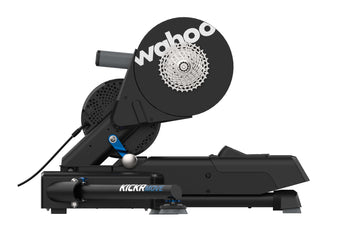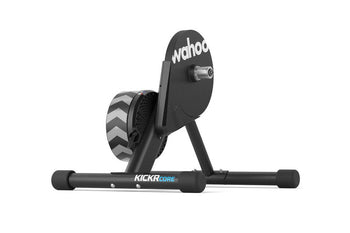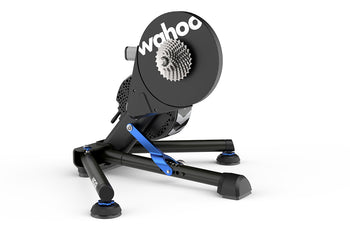
One of the brightest new brands to join cycling in recent years, Wahoo have added a new trainer unit to their line up.
Wahoo KICKR Move is the premium option in Wahoo’s smart trainer line up. It sits above the popular and flagship machine, the KICKR V6 (now in its sixth generation). Wahoo KICKR Move sits below in the line up. All the trainers feature direct drive technology and don't need a training wheel, instead you remove the wheel from your bike and use a cassette mounted to the trainer.
Wahoo KICKR V6, KICKR MOVE and CORE Comparison
Direct drive trainers provide the greatest real world ride feel compared to a older style turbo trainers where a tyre would be mounted against a roller. Wahoo takes ride feel one step further...
KICKR Move features dual axis movement. A rocker moves the bike forward and backwards up to 20 centimetres and suspension in the feet of the unit, known as AXIS Action Feet, provide side to side movement to provide, what Wahoo say, is the most realistic ride experience. When you climb out of the saddle, shift your position on the saddle or accelerate and change power, the KICKR Move will move your bike as it would on the road. This makes for a more comfortable ride but helps keep your body working key muscles, not just your legs, so that outdoors you can ride longer and harder than ever before.

KICKR V6 comes with AXIS feet (backward compatible with other KICKR models). These feet allow up to 5 degrees of movement so the KICKR can respond more naturally to the rider's tempo and body position changes. KICKR Core does not feature AXIS feet or the fore and aft movement.


It is all in the Flywheel
The bigger the flywheel the more inertia and more realistic the road feel, as well as greater maximum watts.
The main difference is that Wahoo KICKR Move and Kickr V6 have a bigger flywheel, the unit can provide 2,200 watts of resistance with 1% accuracy, and is designed to withstand the intense forces dished out by the most powerful cyclists in the world, like pro team partners, EF Eduction. That means if you're going for an all out sprint, whether it be on Zwift or TrainerRoad, the unit won't be the limiting factor — it will be your legs!
In comparison, the KICKR Core offers 1,800 watts of resistance with 2% accuracy, which is higher than its competitors, the Elite Directo (1,400 watts) and Tacx Flux 1 (1,500 watts). Eighteen-hundred watts is plenty for most riders, but it won't suit track sprinters.
The KICKR Core has a flywheel weight of 5.4kg, which is a similar size to earlier versions of the KICKR Smart Trainer.

Size and set up
Thankfully, the design, ergonomics and well-positioned weight of the Wahoo KICKR V6 and Move make them some of the easiest turbo trainers to move and store. The legs fold flush against the body of the unit. It also doesn’t need any assembly when it arrives; you can just lift it straight out of the box.
KICKR Core is lighter because the flywheel is smaller. Out of the box, it requires you to bolt the legs on, but you only need to do it once. Only the front legs fold in slightly to aid storage, but it isn't as compact and, unlike the KICKR, doesn't have a handle for transport. Before you start riding the Core, you will need to make an additional purchase as the unit doesn't come with a cassette, unlike the KICKR V6 or KICKR Move, which is supplied with a Shimano 105 cassette.
What is the same?
The biggest selling point of the Wahoo KICKR range is the drive belt, which is pretty much silent, thanks to its ribbed belt design.
KICKR V6, KICKR MOVE and KICKR CORE are all optimised to work with the Wahoo’s Headwind and Climb. However, KICKR Move requires you to purchase a base adapter. Connection via Bluetooth or ANT+ is easy, and the units allow you to do both at the same time. External apps like Zwift, RGT and TrainerRoad work seamlessly, and while we're yet to explore others, being open source means the units should be able to connect to pretty much anything.

What KICKR should you choose?
Is Wahoo KICKR range worth it? The Wahoo KICKR V6 Smart Trainer remains one of the best trainers on the market, thanks to the sharpened up feel from the new belt, large flywheel and AXIS feet.
KICKR Move goes one step further and is ideal for riders who struggle to feel comfortable on a static unit, riders who want to improve their whole body, or riders who are used to the feel and balance of rollers but want to train with more power than traditional rollers can provide.
The KICKR Core represents great value, with a decent flywheel, and is ideal for riders who are new to indoor training and riding with power, may not need to move their unit frequently or don't intend to spend long stints (40 minutes plus) on their indoor trainer.
Discover Wahoo Kickr Smart Trainers

QUICK ADD
Wahoo Kickr Move Smart Trainer

QUICK ADD
Wahoo Kickr Core Smart Turbo Trainer















